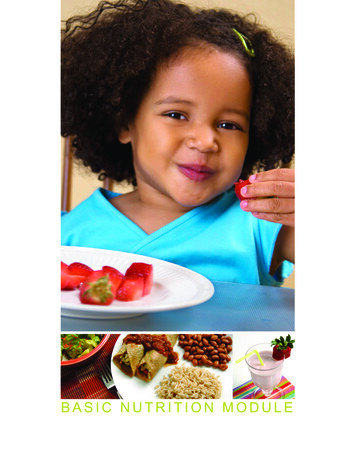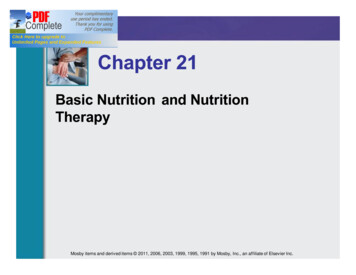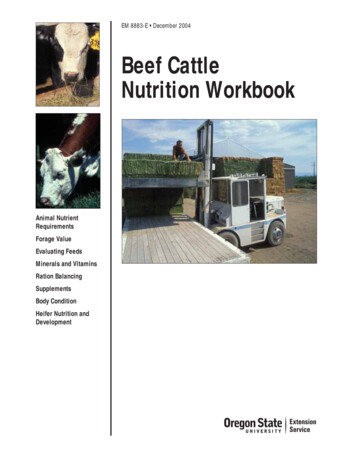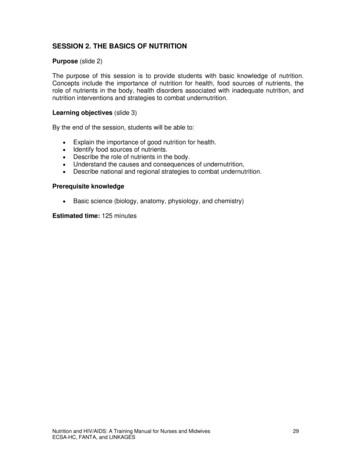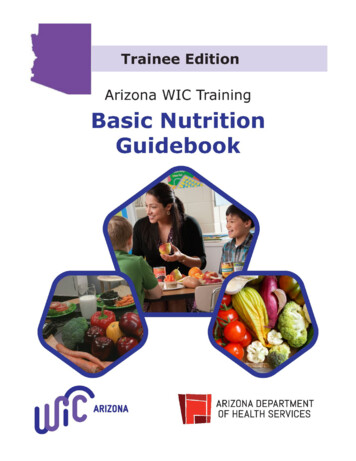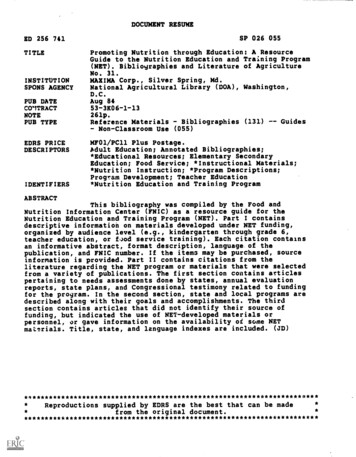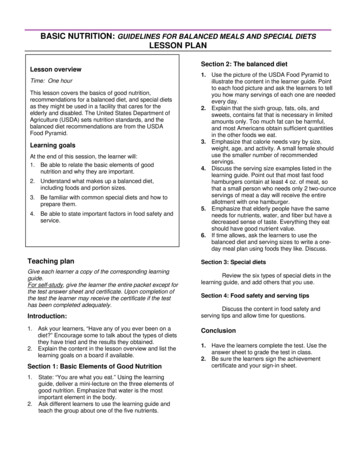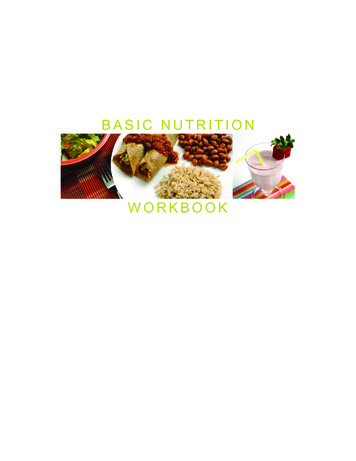
Transcription
BASIC NUTRITIONWORKBOOK
WorkbookBasic Nutrition WorkbookAbout the Basic Nutrition WorkbookThis workbook contains activities and test questions that pertainto information in the Basic Nutrition Module as well as some keyreference tables. This workbook is your personal copy to use andkeep. Feel free to write in it and use it to record your answers to theactivities and test questions.Certain activities will ask you to provide personal informationlike personal dietary intake, weight, family history, etc. These aredesigned to help you create personal health goals, so be honest. Noone will see this information but you.Using this Workbook Along with the BasicNutrition ModuleAs you read through the main text of the Basic Nutrition Moduleicons will prompt you to stop and refer to the correspondingactivities and test questions in this workbook.Activities — The activities in this workbook willenhance your learning and help you apply theinformation in the module.Test Questions — This workbook contains six setsof test questions that relate to information in the sixparts of the module.Record your final test answers on the answer sheetsfollowing this page of the workbook. The answer sheets canbe removed from the workbook if you need to submit them to asupervisor. Each local agency has different procedures for checkingtest answers and making corrections. Check with your supervisor tofind out the procedure in your clinic.1-1
WorkbookThings You Will Need to Complete the Workbook Activities: Computer with Internet access Calculator Your current height and weight measurements Measuring tape Information about your family health history (if available)1-2
WorkbookAnswer Sheets(Use these pages to mark your final answers to the test questions.)Name:Answer Sheet: Part 1 Test1.2.3.4.5.6.7. TRUE TRUE TRUE A B A B A B A B FALSE FALSE FALSE C D E C D C D C D E1-3
WorkbookName:Answer Sheet: Part 2 Test1.2.34.5.6.7.8.1-4 A B C D TRUE FALSE Age Gender Medical conditions Marital Status Hair Color Weight A B C D A B C D TRUE FALSE TRUE FALSE TRUE FALSE
WorkbookName:Answer Sheet: Part 3 Test Energy drinks Plain milk Apple pie Bananas Fruit punch Ice cream2. TRUE FALSE3. TRUE FALSE4. TRUE FALSE5. Shortening Salmon Partially-hydrogenated vegetable oil Whole milk Avocado6. TRUE FALSE7. TRUE FALSE8. TRUE FALSE9. Tomato Egg Beef Peanut butter Olive oil10. TRUE FALSE11. TRUE FALSE12. TRUE FALSE1.1-5
WorkbookName:Answer Sheet: Part 4 Test TRUE FALSE2. TRUE FALSE3. TRUE FALSE4. A B C D5. A B C D6. A B C D7. Spinach Coffee Fortified breakfast cereal Black-eyed peas Asparagus Milk Cream Cheese8. Yogurt Chicken Canned Salmon with edible bones Pork Mozzarella cheese Calcium-fortified orange juice Tea Milk9. A B C D10. A B C D1.1-6
WorkbookName:Answer Sheet: Part 5 Test1.2.3.4.5.6.7.8. Regular soda Apple Doughnut Brown rice Pinto beans Candy A B C D A B C D A B C D A B C D A B C D Eating your lunch in the car on your way into work. Turning off your cell phone during dinner. Watching TV while eating chips out of a bag. Taking time to eat meals slowly. A B C D1-7
WorkbookName:Answer Sheet: Part 6 Test1.2.3.4.5.6.7.8.9. TRUE FALSE TRUE FALSE TRUE FALSE TRUE FALSE TRUE FALSE TRUE FALSE TRUE FALSE A B C D High blood pressure High cholesterol and triglycerides High blood glucose Family history of chronic disease Tobacco use(Note: there are no activities for Part 1)1-8
WorkbookPart 1 Test(Record your final answers on the answer sheets in the front of this workbook.)1. TRUE FALSEPoor diet and physical inactivity may soon overtake tobacco use as the leading preventablecause of death.2. TRUE FALSEMost Americans are physically active on a regular basis.3. TRUE FALSECommon sources of calories among children in the U.S. are grain-based desserts, pizza, andhigh-sugar drinks like sodas and energy drinks.4. Check the factors that have contributed to obesity and overweight among Americans. A. Larger portion sizes. B. Not enough physical activity. C. More convenience foods in grocery stores. D. Less cooking at home. E. All of the above.5. Complete the following sentence by checking all that apply. Food insecurity A. Is not related to income. B. Means not having enough money or other resources to get food throughout the year. C. Is not a concern in the United States. D. All of the above.6. Complete the following sentence by checking all that apply. A food desert is an area where A. People don’t have reasonable access to healthy foods. B. Farmers grow food crops under very hot and dry conditions. C. There is an abundant supply of edible cacti and succulents. D. None of the above.1-9
Workbook7. As a WIC staff member, you can A. Help participants become more food secure each month. B. Help clients understand the benefits of breastfeeding. C. Help WIC families learn how their diet and physical activity choices can affecttheir health in the long run. D. Use this module to help make healthy changes in your own lifestyle. E. All of the above.1-10
WorkbookActivity 2.1 — Using the USDA Nutrient DatabaseHow Much Nutrition is in 1 Medium Carrot?1. Click on the link for USDA’s National Nutrient Database for Standard arch/).2. Click "Start Your Search Here" and type "carrot" into the search box.3. Click on “Carrots, raw.”4. The next window lists different descriptions of raw carrots (whole, grated, chopped, etc.).You can enter specific amounts. For example, you can get nutrient values for 3 mediumcarrots, ½ cup of grated carrots, or 56 grams of carrots.5. The results provide a detailed list of all the nutrients in medium carrots. If you weresuccessful, the results should show you that 1 medium carrot has 25 calories (kcal) of energy,1.7 grams of dietary fiber, and plenty of other nutrients!6. Try one more on your own: How many milligrams of vitamin C are in ½ cup ofchopped raw broccoli? (Answer: 39.2 mg)1-11
WorkbookActivity 2.2 — Keep a One-Day Food Record:For this activity write down all the foods that you eat and drink in a typical 24-hour period,including the amounts. Use the form on the following page to record everything (make copies ifneeded), or create your own form. Start today if possible. Here are some tips: Stick to your usual intake so that your record reflects a typical day. If today is an unusualday in terms of the foods you eat, start your food record tomorrow. Write down everything you eat throughout the day. Include the milk and sugar youput in your coffee, the water you drink, any food samples you try at the store, etc. Keep yourfood record with you wherever you go. Be specific when describing the food. For example, write down “whole-wheat bread”rather than just bread. Write “baked chicken — drumstick,” instead of just chicken. Formixed dishes like casseroles, pizza, sandwiches, etc., make a note of the various ingredients,toppings, etc. The form is there for you — use it however it best suits you. Try to be fairly accurate about amounts. If you aren’t sure how much cereal you eat,pour it into the bowl you usually use, then take it out and measure the amount. The moreaccurate you are about amounts, the more you’ll learn about your own nutrient intake andfood habits.Once you finish your food record keep it handy. You won’t need to do a complete analysis ofyour nutrient intake for this activity, but later in the module you will refer to your food record tosee how some of your usual food choices measure up in terms of nutrients.Note: To keep this food-record activity simple we’ve asked you to track just a single day. Butkeep in mind a single day doesn’t tell the whole story. What really matters are the nutrientsyou get over the course of several days.1-12
WorkbookOne-Day Food RecordName:TimeFood Amount and DescriptionDate:Other Notes1-13
WorkbookPart 2 Test(Record your final answers on the answer sheets in the front of this workbook.)1. Which of the following nutrients provide calories? A. Carbohydrates B. Fats C. Protein D. All of the above2. TRUE FALSEOne teaspoon of sugar has more calories than one teaspoon of oil.3. Which items influence a person’s nutrient needs? (Check all that apply.) Age Gender Medical ConditionsMarital StatusUse this Nutrition Facts Label for questions 4-6Nutrition FactsServing Size 1 cup (228g)Servings Per Container 2Amount Per ServingCalories 250 Calories from Fat 110% Daily ValueTotal Fat 12g18%Saturated Fat 3g15%Trans Fat 3gCholesterol 30mgSodium 470mg20%Total Carbohydrate 31g10%Dietary Fiber 0g0%Sugars 5gProtein 5gVitamin AVitamin CCalciumIron4%2%20%4%*Percent Daily Values are based on 2,000calories diet. Your Daily Values may be higheror lower depending on your calories needs.Calories 2,000Total FatLess thanSat FatLess thanCholesterolLess thanSodiumLess thanTotal Carbohydrate 300gDietary Fiber2,50065g80g20g25g300mg300mg2,400mg 2,400mg375g25g30g(Source: http://www.eatright.org/Public/content.aspx?id 10935)1-14 Hair ColorWeight
Workbook4. How many calories are in one serving of this food? A. 110 B. 250 C. 470 D. 5005. How many calories would you be eating if you consumed the entire package of this food? A. 110 B. 250 C. 470 D. 5006. TRUE FALSEThis food is high in calcium.7. TRUE FALSEThis food is high in fiber.8. TRUE FALSEOne serving of this food has 18 grams of fat.1-15
WorkbookActivity 3.1 — Added Sugars Reality Check.Eating healthy is a matter of balance and moderation. A healthy diet can include added sugarsbut if you are always reaching for candy and cookies instead of healthier snacks that’s aproblem. If you are trying to eat fewer calories, cutting back on simple sugars will help. Look atyour one-day food record and circle at least two foods that you know are high in added sugars.If you are not sure, go back to your pantry and check the ingredient labels for added sugars.Answer the following questions for each food the best you can:Food #1Food #2How often do you eat this food?Do you eat this food out of habit?How many calories does this food have?Does the food provide key vitamins and minerals?Is this a food you would like to cut back on?Activity 3.2 — Are You Getting the Right Kinds of Fats?Look at your one-day food record and write down some of the foods you ate that you know arehigh in fat. If you aren’t sure, go back to your pantry and check the labels for total fat as well assaturated fat, trans fat, and polyunsaturated fat.Circle the foods that you know contain mostly good fats (olive oil, canola oil, peanut oil, sesameoil, avocados, olives, many nuts, nut butters, seeds, soybean oil, corn oil, safflower oil, and theoils in fatty fish). If your list includes a lot of harmful fats (butter, baked goods, chicken skin,solid fat from beef, pork, bacon, etc.), then think about ways you can cut down on harmful fatsin your diet and replace them with good fats.1-16
WorkbookActivity 3.3 — How Much Protein Did You Eat Yesterday?Look at your one-day food record and estimate the grams of protein you ate using Table 3.3 inthe Basic Nutrition Module. The table is also included here for easy reference. If needed, checkfood labels for protein content of packaged foods that you ate.Approximately how much protein did you eat? gramsApproximate Protein Content of Different FoodsFoodGrams of protein3 ounces meat, fish, poultry213 ounces of tofu, firm138 ounces of lowfat yogurt118 ounces of milk8½ cup of cooked beans82 tablespoons peanut butter81 ounce of cheese7¼ cup nuts71 large egg6½ cup cereal31 slice bread2½ cup of grains/pasta, cooked2½ cup non-starchy vegetables, cooked2Fruits0Oils01-17
WorkbookPart 3 Test(Record your final answers on the answer sheets in the front of this workbook.)1. Which of these foods contain added sugars? (Check all that apply.) Energy drinks Plain milk Apple pie Bananas Fruit punch Ice cream2. TRUE FALSEYou can tell if a bread is a whole grain bread by looking at the color.3. TRUE FALSEAll plant foods contain fiber.4. TRUE FALSEA diet high in whole grains can lower risk for heart disease.5. Which of the following contain harmful fats? (Check all that apply.) Shortening Salmon Partially-hydrogenated vegetable oil Whole milk Avocado6. TRUE FALSEEating large amounts of saturated fats raises the risk for cardiovascular disease.1-18
Workbook7. TRUE FALSESalmon, tuna, mackerel, herring and trout are good sources of omega-3 fats.8. TRUE FALSEIf the ingredient list shows “partially-hydrogenated vegetable oil” as an ingredient, then theproduct contains trans fat.9. Which of these foods contain cholesterol? (Check all that apply.) Tomato Egg Beef Peanut butter Olive oil10. TRUE FALSEYou can get all the protein you need by eating only plant foods.11. TRUE FALSEThe body needs more protein during periods of growth (like childhood and pregnancy).12. TRUE FALSEMost Americans need to eat more protein than what they are currently eating.1-19
WorkbookActivity 4.1 — How much sodium is in your foods?Go home and read the nutrition labels on your packaged foods. You will quickly see which itemsare high in sodium and which foods routinely supply lower amounts of sodium that can add up.If you eat out a lot, get the nutrition information for your favorite entrees.List the top three sources of sodium either from your pantry or from your 1-day food record:What steps can you take to start cutting back on sodium? List one thing you are willing to trythis month:Activity 4.2 — What are Your Favorite Sources of Key Vitamins andMinerals?Review the tables in part 4 that list food sources of various nutrients (or refer to the food listsin Appendix C of this workbook). Write down at least one of your favorite foods for e
Nutrition Facts Serving Size 1 cup (228g) Servings Per Container 2 Amount Per Serving Calories 250 Calories from Fat 110 % Daily Value Total Fat 12g 18% Saturated Fat 3g 15% Trans Fat 3g Cholesterol 30mg Sodium 470mg 20% Total Carbohydrate 31g 10% Dietary Fiber 0g 0% Sugars 5g Protein 5g Vitamin A 4% Vitamin C 2% Calcium 20% Iron4% *Percent Daily Values are based on
